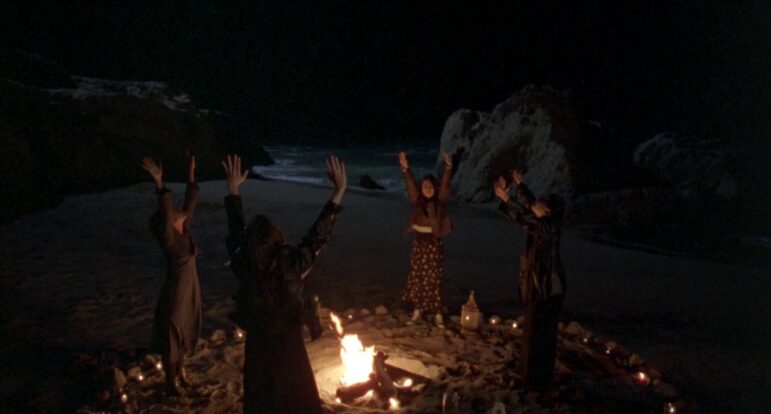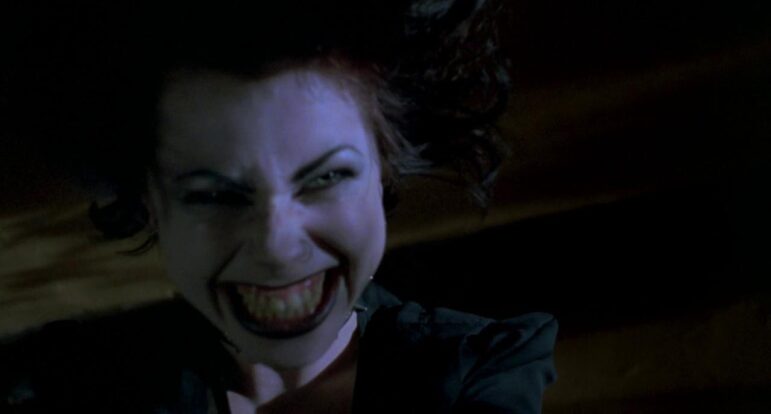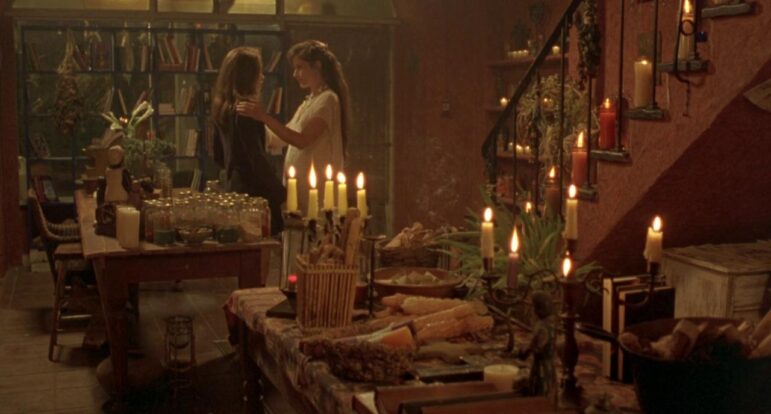
When The Craft came out in 1996, I was already a Witch. But nobody had ever taught me how to cast a circle.
Like a lot of converts, I was full of enthusiasm but had no prospects for a teacher or a coven. I loitered around the local metaphysical shop, looking for some wise older Witch who would know me on sight and take me home and show me the steps. She never materialized. Instead, I read every book on the shelf and did it like most kids in the 90s: alone, with only printed words to guide me.

Sarah (Robin Tunney), Nancy (Fairuza Balk), Bonnie (Neve Campbell), and Rochelle (Rachel True) cast a circle in Andrew Fleming’s “The Craft” (1996) [Columbia Pictures]
Although there’s a little panic every time there’s a new and titillating movie about Witches, there are no mainstream films that will actually teach a teenager how to practice Witchcraft. Witchlings today have access to every practitioner on YouTube and TikTok. In a less sophisticated age, I had Sarah, Nancy, Rochelle, and Bonnie doing more Wiccan ritual pantomime than I could see anywhere else.
The Craft tells the story of a new girl in a Catholic school, Sarah Bailey (Robin Tunney). Sarah’s mother died giving birth and the girl sports a pair of scars from past attempt on her own life. A little lost and lot unhappy, Sarah finds a group of girls one boy in her cohort calls “the bitches of Eastwick.”
Led by stunning goth Nancy (Fairuza Balk), the coven is rounded out by Bonnie (Neve Campbell), a shy girl with extensive burn scars on her back and arms, and Rochelle (Rachel True), a competitive diver who suffers aggressive racism from her teammates as one of the few visible Black students in their Los Angeles parochial school. On Sarah’s first day, the girls consult their almanac and read a prophecy that promises them wholeness; the four elements in balance at last. They wonder aloud whether their coven of three might become four.
No surprises here: the new girl is destined to complete their circle. Sarah is a Witch, because her mother was a Witch. Spooky coincidences follow the new girl, and she shows off an impressive (if erratic) array of powers. Linked together, the girls accomplish multiple murders, reversals of fortune, impeccable glamours, and one of the most glorious retributions ever granted to an onscreen racist in cinematic history.
What is a surprise is that The Craft is one of the only movies that shows, not in montage or in dream sequence, not in hints or in glimpses through a not-quite-closed-door, how Witches cast a circle, consecrate their spaces, and bring one another into the space between worlds.

Fairuza Balk as Nancy in Andrew Fleming’s “The Craft” (1996) [Columbai Pictures]
There are hints in other films. There is a circle of containment shown peripherally in Skeleton Key (2005) and another chalk-drawn circle of protection in Sleepy Hollow (1999). Elements of verbal casting of circle take place in The Devil Rides Out (1968) and altar construction appears in Season of the Witch (1973). Preparation and arrangement for ceremonial magic is shown in trace amounts in A Dark Song (2016), and Shakespearean pentameter accompanies the action of casting a circle on the earth in The Tempest (2010), with Helen Mirren as Prospero the magician.
There is a breadcrumb trail of workings on television. A circle of power is conjured in an episode of Poltergeist the Legacy, and circular boundaries of salt are laid in True Blood and Supernatural. 90s pop-occult touchstone Buffy the Vampire Slayer offers picturesque but uneven and mostly unfounded moments of small-screen Witchcraft. American Horror Story: Coven blundered once or twice into a liturgy or a prayer a practicing Witch might recognize.
Not one of these examples comes close to what takes place in The Craft. Producers of the film hired Wiccan priestess and Covenant of the Goddess officer Pat Devin for the task of bringing verisimilitude in the ritual elements. Devin expressed a desire for the Witch-girls to engage in behavior that was “authentic, if generic.”
It felt anything but generic as a 15-year-old Witch who had never heard the words before. “Hail to the guardians of the watchtowers of the east, the powers of air and invention. Hear us.” I still remember gooseflesh erupting across my chest in the blasting cold air from the vents in the theater. The movie came out just after Beltane that year, but I couldn’t see it until almost Midsummer. I carried the June heat into the cool, dark cinema with me and I burned from within as soon as the action got started. I recognized it as a horror film; I didn’t think I could learn to step through a mirror to defeat my enemy, and I knew better than to think anything of the Witches’ ahistorical godhead “Manon.”
But each act of generic Wicca pricked me as I recognized specificity and procedure. I watched Sarah wrap white ribbon around a photo of her covenmate while speaking a binding. I absorbed the warning of initiation: “it is better that you should rush upon this blade…” I heard the girls give one another the passwords of perfect love and perfect trust, though they had not built either within their circle.
I knew what I was watching. I knew what I wanted. The girls on screen dripped their blood into a shared chalice and drank of their sisterhood. I was thirsty.

Robin Tunney as Sarah and Assumpta Serna as Lirio in Andrew Fleming’s “The Craft” (1996) [Columbia Pictures]
Rewatching the movie 27 years later, I recognize different things. I feel that I can sense the work Devin was doing to give up something good without giving away anything secret. There’s enough legitimate practice there to set someone on the path if they’ve never seen it before, and enough to signal to an experienced practitioner that this is at least a well-informed bit of schlock horror about teenage Witches.
Most of all, I recognize Lirio. The only adult practitioner in the film, Lirio (Assumpta Serna) runs the local occult shop. The girls steal from her and shop her wares, seeking out books, bells, and candles. Lirio offers advice and support with a dash of intuition, but she doesn’t intervene when coven business turns dire. I saw myself in the girls when I first saw the film: precocious, pubescent, and plenipotentiary. Like them, I was buying anything I could afford and trying out anything that might work, anything that might make me feel connected to the power I could feel running through the world around me.
This time, I saw myself in Lirio. Older and wiser, I can offer some knowledge to the kids who come to me for books and candle dressing, for advice and for how to call the corners. She won’t have to pick up bits from books and mine the movies for the stuff she’s never seen. I can tell her that it is better than she rush upon this blade… and I can walk her into the circle.
But the last 27 years have taught me that I can only walk her so far. After that, it’s up to her.
The Craft is currently available to stream on Max and the Criterion Channel.
The Wild Hunt is not responsible for links to external content.
To join a conversation on this post:
Visit our The Wild Hunt subreddit! Point your favorite browser to https://www.reddit.com/r/The_Wild_Hunt_News/, then click “JOIN”. Make sure to click the bell, too, to be notified of new articles posted to our subreddit.
